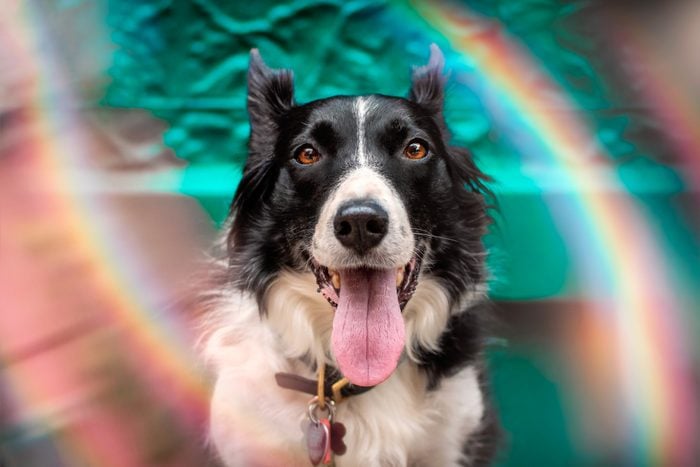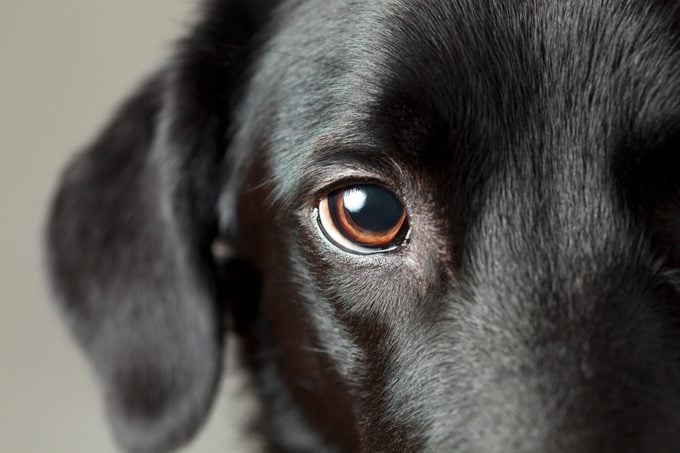Can Dogs See Color? Learn All About a Dog’s Color Spectrum
Updated: Mar. 12, 2024

Can your pooch even see that yellow tennis ball in the grass? Find out if dogs can see color.
If you’re lucky enough to live with a pooch or two, you’ve probably spent a decent amount of time trying to figure out dog behavior. But trying to see things from your dog’s point of view brings up another question: Can dogs see color?
You may know if dogs can see in the dark, but many people believe that when it comes to distinguishing green grass from a blue sky, dogs are totally color-blind and can only see in black and white. However, as science has advanced and we’ve learned more about the other animals who share our planet, researchers think they’ve finally found out exactly what your dog can see when they stare at you. It turns out that dogs don’t see only in black and white after all.
Are dogs color blind?
The answer is a little bit complicated. “Dogs can see color,” says Zay Satchu, DVM, Chief Veterinary Officer of Bond Vet. “Both humans and animals have different types of cells in the back of their eyeballs—called rods and cones—that help them see. Rods detect motion and help with nighttime vision, and cones help with color and detail in what we see. Humans have three kinds of cones, meaning we see color and detail very well, while dogs have two kinds, meaning they can still pick up on colors but probably can’t differentiate between forest and lime green as easily.”
However, by human standards, dogs are definitely color blind. According to Britannica, a common type of color blindness in humans is known as dichromacy, meaning the eye has only two working cones, as opposed to the regular trichromacy, or three working cones. Humans with dichromacy might see the world in something close to the dog color spectrum. Have you ever wondered what colors cats can see?
What colors can dogs see?
They may not be able to see the whole rainbow, but it seems that your pooch can see a couple of colors really well: blue and yellow. “Most dogs can’t see much of red or green at all,” explains Dr. Satchu. While they can see some colors, the nuances of those colors (like the difference between plum and violet) are probably lost on dogs. Maybe that’s why dogs love bright yellow tennis balls so much: They can see them clearly against the gray or brown that dogs see when they look at something green, like your freshly mowed lawn. That’s something to keep in mind when you’re picking out your dog’s next puzzle toy. If you want to see the world through your dog’s eyes, download the Dog Vision app and take a look.
However, the dog color spectrum includes colors that humans can’t see, says Dr. Satchu. “The other ‘color’ that exists that humans can’t see but dogs can is ultraviolet, meaning ‘beyond violet.’ We’re still evaluating the true purpose of this vision, but we think it has to do with the ability to pick up on the kinds of substances that contain ultraviolet light, like urine and blood, that help with tracking out in the wild,” she explains. When you think about how ultraviolet light would contrast with the grey-brown background of the forest, it makes sense that your dog’s vision is adapted to help them hunt. After all, we all know that dogs have superpowers.
What does a dog’s vision look like?

Now we know that dogs see a limited spectrum of colors, but how far can they see? According to PetMD, dogs have visual acuity of around 20/75. Normal human vision is considered to be 20/20, so dogs have to be 20 feet away to see an object as clearly as a human can see it from 75 feet. Most dogs have pretty blurry vision—if they were human, they’d need glasses to see faraway objects. However, Labrador Retrievers have better eyesight than most dogs. It’s closer to 20/20, which is why they’re often used as service dogs (here’s why you can’t pet a service dog).
Dogs may have fewer cones for seeing color than humans do, but they have many more rods in their retina than we do, which makes them much better at seeing movement—essential for a hunting animal. In fact, dogs can see moving objects much more clearly than they can stationary objects, and their motion sensitivity is up to 10-20 times greater than ours. That’s how they see a squirrel in the park before you do! It’s just one of the things your dog wishes you knew.
Source:
- Zay Satchu, DVM, Chief Veterinary Officer of Bond Vet



